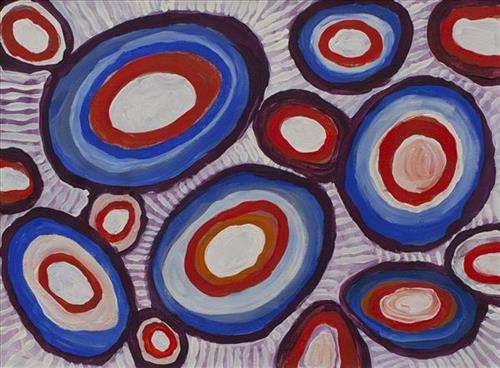111581940982
Katjarra (Kadjarra, Kajarra, Carnarvon Range)
“In the Jukurrpa (Dreamtime) the yalapara (perentie goanna) was walking around here, travelling around my grandfather’s Country. This is his Jukurrpa, [and] so was the jila (snake), Katjarra, who brings the kapi (rain). He lives in a rockhole in this Country, at the top [of the mountain range], where there is a waterfall. It’s in the heart of Birriliburu. In the pujiman (traditional, desert dwelling)] days the old people went to Katjarra to sing out to bring down the water.
This was the camping ground for the old people, they used to stop here, all of the families. This is Atkins’ and Kadibil family’s Country. Atkins and Kadibils would camp with each other; other families would visit us here. The old people would come around looking for water. They would call out to the snake to send down the water. They would have to call in Putijarra language, as this is the only language the snake knows. When you talk to him, he sends the water down. We had good water here, we had a drink out of it”.
– Miriam Atkins
Katjarra (Carnarvon Range) mountain ranges are part of Miriam’s ngurra (home Country, camp). The mountain range, distinctive from a distance for its blue hue, is located in the south western corner of Birriliburu Indigenous Protected Area. This region lies at the southern end of Martu Country and at the intersection of the Little Sandy and Gibson Deserts of Western Australia. Katjarra was an important camping place for Martu walking between Jigalong and Wiluna for law business up until the late 1960s, as well as Martu who walked the Canning Stock Route into Wiluna. Katjarra was also the site of the 2008 Birriliburru Native Title Determination, one of the first land grants to Martu.
Within the Katjarra mountain range are many water sources, including a culturally significant creek close to Milyinirri (Canning Stock Route Well 6), also named Katjarra. This creek is home to a rainmaking jila, as described by Miriam. Its waters cascade down the hill from here. The Western Desert term jila is used interchangeably to describe springs considered to be ‘living’ waters and snakes, both of which play a central role in Martu culture and Jukurrpa. During the pujiman period, knowledge of water sources was critical for survival, and today Martu Country is still defined in terms of the location of water sources. Of the many permanent springs in Martu Country, very few are ‘living waters’; waters inhabited by powerful ancestral snakes. Before they became snakes, these beings were men who made rain, formed the land and introduced cultural practices like ceremonies and ritual songs. Some of the men travelled the desert together, visiting one another, but they all ended their journeys at their chosen spring alone, transformed into a snake. These important springs, like Katjarra, are named after their jila inhabitant.
Katjarra also features as a site in the Minyipuru (Jakulyukulyu, Seven Sisters) Jukurrpa, and that of the yalapara, the ancestral goanna being described by Miriam who was responsible for the creation of many significant land features in the area.




